Beyond Traditional Energy Sector Coupling: Conserving and Efficient Use of Local Resources
Abstract
:1. Introduction
- What are the energy recovery and resource utilisation potentials of waste and wastewater treatment in a holistically considered energy system, and how do they affect the operation of other energy system technologies?
- What is the impact of water as a limited resource, and what benefits to energy system operations emerge through greywater use?
- Which CO2 emissions are generated by the use of energy recovery technologies combined with conventional technologies, and can a transition to a hydrogen-based energy system lead to emission reductions?
2. State-of-the-Art
2.1. Waste, Water Energy Recovery, and Resource Utilisation
2.2. Greywater Utilisation
2.3. Sector Coupling
2.4. Novelties and Progress beyond the State-of-the-Art
- (i)
- Inclusion of both waste and water resource utilisation and energy recovery technologies into a multiple energy sector coupling approaches with additional consideration of CO2 emissions.
- (ii)
- Impact assessment of greywater use in sector coupling with particular analysis considering water scarcity periods.
- (iii)
- Comparison of waste and water energy recovery potential and greywater utilisation in gas- and hydrogen-based energy systems.
- (iv)
- (v)
- Identification of the relationship between energy recovery technologies, conventional conversion technologies, and external procurement in gas- and hydrogen-based energy systems.
3. Materials and Methods
3.1. Investigation Setup
3.2. Energy Recovery Optimisation Model
3.2.1. Workflow
3.2.2. Objective Function
3.2.3. Constraints
3.3. Water Scarcity
3.4. CO2 Emissions
3.4.1. CO2 Price
3.4.2. CO2 Emission Minimisation
3.5. Case Study Setup
3.6. Model Validation
4. Results
4.1. Energy Recovery
4.2. Water Scarcity
4.3. CO2 Emissions
4.4. Hydrogen Economy
4.5. Relationship between Energy Recovery and Energy System Operations
5. Discussion
5.1. Potential and Implementation of Energy Recovery
5.2. Greywater: Opportunities and Barriers
5.3. Transition to Hydrogen in Water-Scarce Countries
5.4. Complexity in Energy Recovery Relations
6. Conclusions
Author Contributions
Funding
Institutional Review Board Statement
Informed Consent Statement
Data Availability Statement
Acknowledgments
Conflicts of Interest
Nomenclature
| Sector inputs | index: n | |
| Sector outputs | index: m | |
| Set with all considered sectors | index: k | |
| Set with implemented technologies | index: i | |
| Set with implemented sources | index: j | |
| Set of all disposal time steps | index: d | |
| Parameters | ||
| T | Total time steps | |
| Technology input costs | € per | |
| Technology output costs | € per | |
| Specific purchase costs | € per | |
| Maximum power | ||
| Maximum processed volume | ||
| Maximum processed mass | ||
| Time step | ||
| Disposal interval | ||
| Disposal time step | ||
| Storage standby efficiency | / | |
| Storage input efficiency | / | |
| Storage output efficiency | / | |
| State of charge at beginning | [sector] | |
| Technology conversion factor | ||
| Technology resource deployment | ||
| Water demand | ||
| Maximum greywater contribution | / | |
| Water scarcity factor | / | |
| CO2 price | € per | |
| CO2 factor | per | |
| Energy recovery relation | /kg | |
| Decision Variables | ||
| Operational technology costs | € | |
| External purchase costs | € | |
| Total costs | € | |
| Input flow | Generic unit | |
| Output flow | Generic unit | |
| External purchased flow | [sector] | |
| Additional resource flow | [sector] | |
| Energy flow | ||
| Volume flow | ||
| Mass flow | ||
| Storage state of charge | [sector] | |
| Potable water to water demand | ||
| Greywater to water demand | ||
| Water demand electrolysis | ||
| Technology and source emissions | ||
| Total emissions | ||
| Total emissions costs | € | |
| Total costs including emissions | € | |
Appendix A. Case Study Setup and Assumptions


| Tech | Elec | Heat | Waste | Water | Gas | H2 |
|---|---|---|---|---|---|---|
| PV Generation | Out | / | / | / | / | / |
| Desalination | In | / | / | Out | / | / |
| P2H | In | Out | / | / | / | / |
| Hot Water | / | In/Out | / | In | / | / |
| Waste Comb. | Out | Out | In | / | / | / |
| Waste Biogas | / | / | In | / | Out | / |
| Waste H2 | / | / | In | / | / | Out |
| Gas CHP | Out | Out | / | / | In | / |
| Gas Boiler | / | Out | / | / | In | / |
| Blockheat | / | Out | / | / | In | / |
| Sewage Treat. | In | Out | / | In/Out | / | / |
| Sludge Comb. | Out | Out | / | In | / | / |
| Sludge Biogas | / | / | / | In | Out | / |
| Sludge H2 | / | / | / | In | / | Out |
| Electrolysis | In | / | / | In | / | Out |
| H2 CHP | Out | Out | / | / | / | In |
| Fuel Cell | Out | / | / | / | / | In |
| H2 Boiler | / | Out | / | / | / | In |
| Technology | Limit | Conversion | Costs | Comment |
|---|---|---|---|---|
| Elec. grid | 80 MW | / | 15 ct/kWh | 11 kW per household [102] |
| PV | MW | Standard profile | / | Half of households with PV |
| Heat pump | MW | COP time-series | ct/kWh | [103,104] |
| Battery | MW | of 0.95 | ct/kWh | 6% of households [105] |
| Desalination | 150 | 3 kWh/ elec. | 44 ct/ | [106,107] |
| Demand | / | 3400 kWh | / | [108] |
| Technology | Limit | Conversion | Costs | Comment |
|---|---|---|---|---|
| Boiler | 33 MW | of 0.95, water of 17l/kWh | / | [109] |
| Heat storage | 473 | of 0.8 | ct/kWh | [110,111] |
| Demand | / | 35 GWh | / | [112] |
| Technology | Limit | Conversion | Costs | Comment |
|---|---|---|---|---|
| Storage | 1343 | / | / | Disposal periods |
| Stock | 51580 | / | / | No disposal periods |
| Accruing | / | 612 kg/year | / | [113] |
| Disposal | / | 1343 | ct/kg | [114] |
| Combustion | 75 MW | of 0.35, of 0.4 | ct/kWh | [115] |
| Technology | Limit | Conversion | Costs | Comment |
|---|---|---|---|---|
| Demand | / | 758520 | / | [116] |
| Storage | 5988 | / | 1 ct/ | Basic assumptions |
| Sewage treatment | / | of 0.95, of
kWh/ | 4 ct/ | [117,118] |
| Sewage sludge | / | kg/ | / | Based on sludge parameters |
| Sewage heat | / | kWh/ | / | [119] |
| Sludge combustion | MW | of 0.35, of 0.4 | 6 ct/kWh | Same as waste combustion |
| Sludge disposal | / | / | 23 ct/kg | Same as waste |
| Technology | Limit | Conversion | Costs | Comment |
|---|---|---|---|---|
| Demand | / | 5112 MWh | / | [120] |
| Grid | 1000 MW | / | / | [121] |
| Blockheat | MW | Efficiency 0.44 | ct/kWh | [122,123] |
| Boiler | MW | Efficiency 0.95 | ct/kWh | Like waste combustion (higher efficiency) |
| Co-generation | MW | of 0.35, of 0.4 | ct/kWh | Like waste combustion [124] |
| Anaerobic digestion | Waste: 75 MW Sludge: MW | kggas/kg | 7 ct/kg | [21] |
| Technology | Limit | Conversion | Costs | Comment |
|---|---|---|---|---|
| Demand | / | 5112 MWh | / | Same as for gas |
| Storage | 6 GWh | efficiency 0.6 | ct/kWh | [125,126,127] |
| Electrolysis | 50 MW | electricity kWh/
, water 1 l/ | ct/ | [128,129,130] |
| Fuel cell | MW | efficiency 0.6 | ct/kWh | [131,132] |
| Boiler | MW | efficiency 0.95 | ct/kWh | Like gas boiler |
| Co-generation | MW | of 0.35, of 0.4 | 3 ct/kWh | [133] |
| Anaerobic digestion | Waste: 75 MW Sludge: MW | 15 gH2/kg | 7 ct/kg | [134] |
| Technology | Emissions | Comment |
|---|---|---|
| Elec. grid | kg/kWh | [92] |
| Gas grid | kg/kWh | [93] |
| Gas boiler | kg/kWh | [135] |
| Blockheat | kg/kWh | [135] |
| Gas co-generation | kg/kWh | [135] |
| Waste combustion | kg/kgwaste | [94] |
| Waste disposal | kg/kgwaste | [136] |
| Sewage treatment | kg/ | [137] |
| Sludge combustion | 50 kg/ | [135] |
| Sludge disposal | 1456 kg/ | [138] |
| Month | |
|---|---|
| January | 0.95 |
| February | 0.95 |
| March | 0.95 |
| April | 0.95 |
| May | 0.75 |
| June | 0.6 |
| July | 0.6 |
| August | 0.6 |
| September | 0.75 |
| October | 0.9 |
| November | 0.95 |
| December | 0.95 |
Appendix B. Model Validation
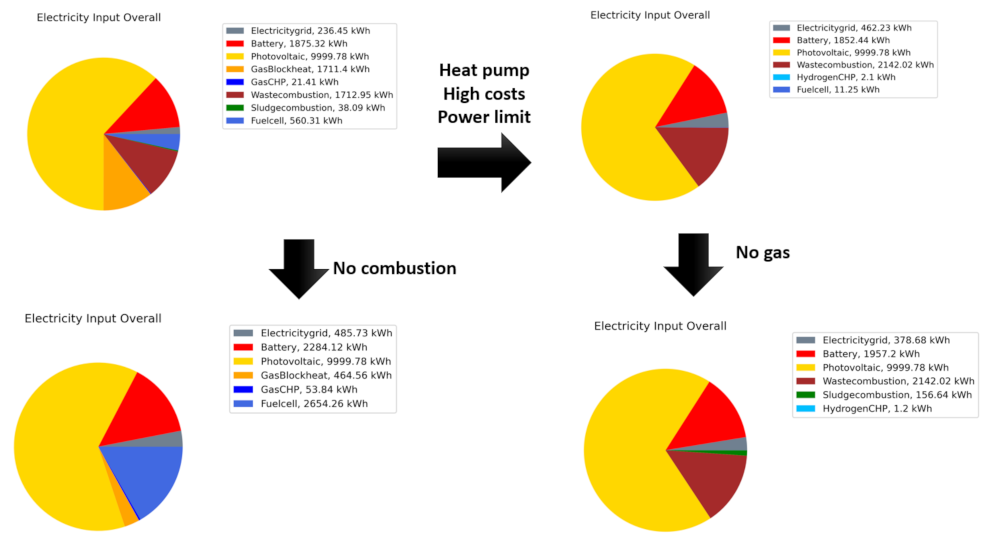
Appendix C. Waste and Sludge Operation Results
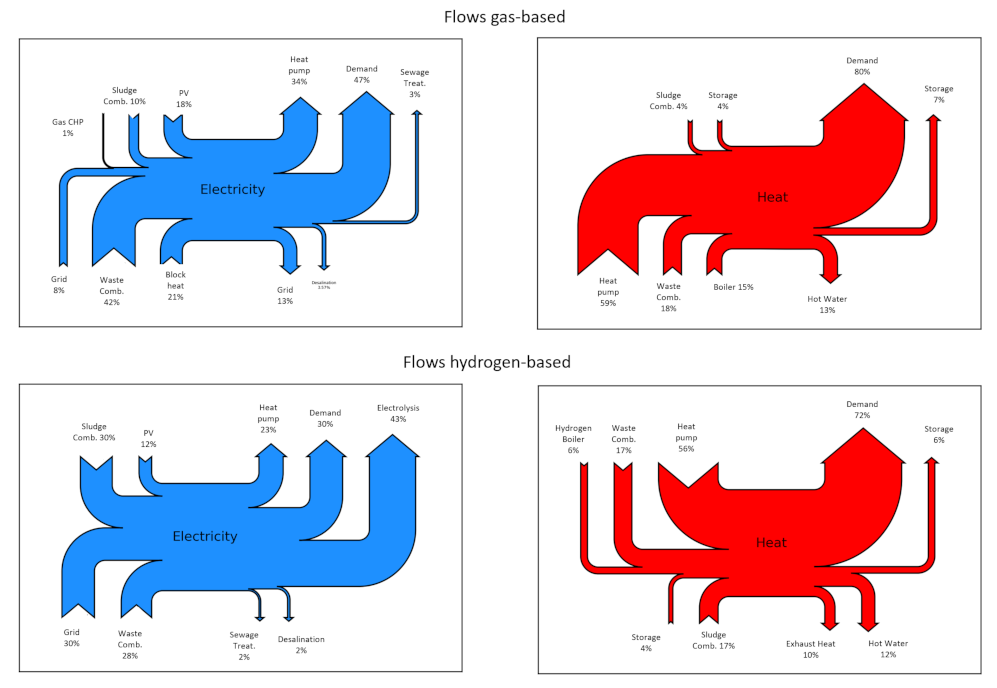


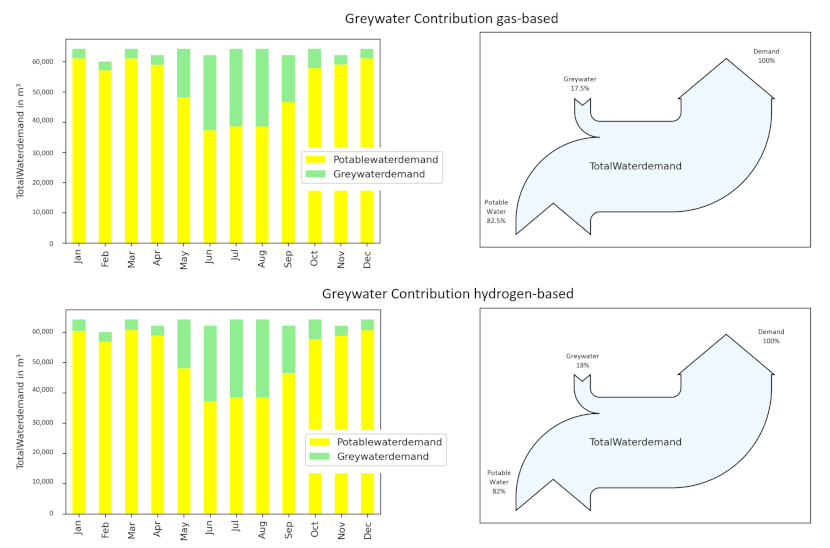
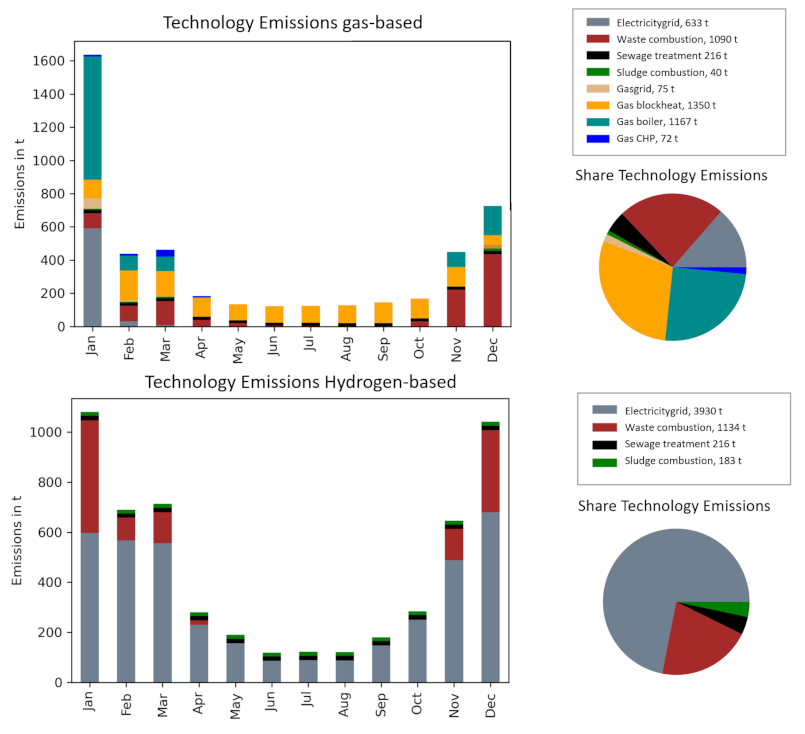
References
- United Nations Deparment of Economic and Social Affairs. Sustainable Development. Available online: https://sdgs.un.org/goals (accessed on 14 March 2022).
- Bundesministerium für Klimaschutz. Das Übereinkommen von Paris. 2022. Available online: https://www.oesterreich.gv.at/themen/bauen_wohnen_und_umwelt/klimaschutz/1/Seite.1000325.html (accessed on 14 March 2022).
- European Commission. Communication from the Commission to the European Parliament, the Council, the European Economic and Social Committee and the Committee of the Regions. 2020. Available online: https://eur-lex.europa.eu/legal-content/EN/TXT/PDF/?uri=CELEX:52020DC0299&from=DE (accessed on 30 April 2021).
- Kumar, A.N.; Russel, I.F. Introduction. Int. J. Pattern Recognit. Artif. Intell. 2000, 14, 1–2. [Google Scholar] [CrossRef]
- Hamiche, A.M.; Stambouli, A.B.; Flazi, S. A review of the water-energy nexus. Renew. Sustain. Energy Rev. 2016, 65, 319–331. [Google Scholar] [CrossRef]
- Oladejo, J.; Shi, K.; Luo, X.; Yang, G.; Wu, T. A Review of Sludge-to-Energy Recovery Methods. Energies 2019, 12, 60. [Google Scholar] [CrossRef] [Green Version]
- Thormark, C. Conservation of energy and natural resources by recycling building waste. Resour. Conserv. Recycl. 2001, 33, 113–130. [Google Scholar] [CrossRef]
- Moya, D.; Aldás, C.; López, G.; Kaparaju, P. Municipal Solid Waste as a Valuable Renewable Energy Resource: A Worldwide Opportunity of Energy Recovery by Using Waste-To-Energy Technologies; Elsevier Ltd.: Amsterdam, The Netherlands, 2017; Volume 134, pp. 286–295. [Google Scholar] [CrossRef]
- Giugliano, M.; Cernuschi, S.; Grosso, M.; Rigamonti, L. Material and energy recovery in integrated waste management systems. An evaluation based on life cycle assessment. Waste Manag. 2011, 31, 2092–2101. [Google Scholar] [CrossRef]
- Dlamini, S.; Simatele, M.D.; Kubanza, N.S. Municipal solid waste management in South Africa: From waste to energy recovery through waste-to-energy technologies in Johannesburg. Local Environ. 2019, 24, 249–257. [Google Scholar] [CrossRef]
- Milutinović, B.; Stefanović, G.; Đekić, P.S.; Mijailović, I.; Tomić, M. Environmental assessment of waste management scenarios with energy recovery using life cycle assessment and multi-criteria analysis. Energy 2017, 137, 917–926. [Google Scholar] [CrossRef]
- Yi, S.; Jang, Y.C.; An, A.K. Potential for energy recovery and greenhouse gas reduction through waste-to-energy technologies. J. Clean. Prod. 2018, 176, 503–511. [Google Scholar] [CrossRef]
- Chen, Y.C. Evaluating greenhouse gas emissions and energy recovery from municipal and industrial solid waste using waste-to-energy technology. J. Clean. Prod. 2018, 192, 262–269. [Google Scholar] [CrossRef]
- Yaman, C.; Anil, I.; Alagha, O. Potential for greenhouse gas reduction and energy recovery from MSW through different waste management technologies. J. Clean. Prod. 2020, 264, 121432. [Google Scholar] [CrossRef]
- Peccia, J.; Westerhoff, P. We Should Expect More out of Our Sewage Sludge. Environ. Sci. Technol. 2015, 49, 8271–8276. [Google Scholar] [CrossRef] [PubMed]
- Hong, J.; Hong, J.; Otaki, M.; Jolliet, O. Environmental and economic life cycle assessment for sewage sludge treatment processes in Japan. Waste Manag. 2009, 29, 696–703. [Google Scholar] [CrossRef] [PubMed]
- Wang, K.; Nakakubo, T. Strategy for introducing sewage sludge energy utilization systems at sewage treatment plants in large cities in Japan: A comparative assessment. J. Clean. Prod. 2021, 316, 128282. [Google Scholar] [CrossRef]
- Singh, V.; Phuleria, H.C.; Chandel, M.K. Estimation of energy recovery potential of sewage sludge in India: Waste to watt approach. J. Clean. Prod. 2020, 276, 122538. [Google Scholar] [CrossRef]
- Quan, L.M.; Kamyab, H.; Yuzir, A.; Ashokkumar, V.; Hosseini, S.E.; Balasubramanian, B.; Kirpichnikova, I. Review of the application of gasification and combustion technology and waste-to-energy technologies in sewage sludge treatment. Fuel 2022, 316, 123199. [Google Scholar] [CrossRef]
- Masuda, S.; Sano, I.; Hojo, T.; Li, Y.Y.; Nishimura, O. The comparison of greenhouse gas emissions in sewage treatment plants with different treatment processes. Chemosphere 2018, 193, 581–590. [Google Scholar] [CrossRef]
- Verstraete, W.; de Caveye, P.V.; Diamantis, V. Maximum use of resources present in domestic “used water”. Bioresour. Technol. 2009, 100, 5537–5545. [Google Scholar] [CrossRef]
- Amulen, J.; Kasedde, H.; Serugunda, J.; Lwanyaga, J.D. The potential of energy recovery from municipal solid waste in Kampala City, Uganda by incineration. Energy Convers. Manag. X 2022, 14, 100204. [Google Scholar] [CrossRef]
- Medina-Mijangos, R.; Seguí-Amórtegui, L. Technical-economic analysis of a municipal solid waste energy recovery facility in Spain: A case study. Waste Manag. 2021, 119, 254–266. [Google Scholar] [CrossRef]
- Kan, A. General characteristics of waste management: A review. Energy Educ. Sci. Technol. Part A 2009, 23, 55–69. [Google Scholar]
- Vasanthi, P.; Kaliappan, S.; Srinivasaraghavan, R. Impact of poor solid waste management on ground water. Environ. Monit. Assess. 2008, 143, 227–238. [Google Scholar] [CrossRef] [PubMed]
- Hasan, M.M.; Rasul, M.G.; Khan, M.M.; Ashwath, N.; Jahirul, M.I. Energy recovery from municipal solid waste using pyrolysis technology: A review on current status and developments. Renew. Sustain. Energy Rev. 2021, 145, 111073. [Google Scholar] [CrossRef]
- Tseng, M.L.; Wong, W.P.; Soh, K.L. An overview of the substance of Resource, Conservation and Recycling. Resour. Conserv. Recycl. 2018, 136, 367–375. [Google Scholar] [CrossRef]
- Zhang, C.; Hu, M.; Maio, F.D.; Sprecher, B.; Yang, X.; Tukker, A. An overview of the waste hierarchy framework for analyzing the circularity in construction and demolition waste management in Europe. Sci. Total Environ. 2022, 803, 149892. [Google Scholar] [CrossRef] [PubMed]
- Khan, S.; Anjum, R.; Raza, S.T.; Bazai, N.A.; Ihtisham, M. Technologies for municipal solid waste management: Current status, challenges, and future perspectives. Chemosphere 2022, 288, 132403. [Google Scholar] [CrossRef]
- Corsten, M.; Worrell, E.; Rouw, M.; Duin, A.V. The potential contribution of sustainable waste management to energy use and greenhouse gas emission reduction in The Netherlands. Resour. Conserv. Recycl. 2013, 77, 13–21. [Google Scholar] [CrossRef]
- Sharafatmandrad, M.; Mashizi, A.K. Temporal and Spatial Assessment of Supply and Demand of the Water-yield Ecosystem Service for Water Scarcity Management in Arid to Semi-arid Ecosystems. Water Resour. Manag. 2021, 35, 63–82. [Google Scholar] [CrossRef]
- Willis, R.M.; Stewarta, R.A.; Panuwatwanich, K.; Jones, S.; Kyriakides, A. Alarming visual display monitors affecting shower end use water and energy conservation in Australian residential households. Resour. Conserv. Recycl. 2010, 54, 1117–1127. [Google Scholar] [CrossRef] [Green Version]
- Zhang, B.; Meng, Z.; Zhang, L.; Sun, X.; Hayat, T.; Alsaedi, A.; Ahmad, B. Exergy-based systems account of national resource utilization: China 2012. Resour. Conserv. Recycl. 2018, 132, 324–338. [Google Scholar] [CrossRef]
- Aivazidou, E. Water Management in Agriculture and Industry: Challenges, Trends, and Opportunities. Sustainability 2022, 14, 66. [Google Scholar] [CrossRef]
- Lee, M.; Kim, H.; Lee, J.Y.; Yang, J.E.; Lim, C. A Shift Towards Integrated and Adaptive Water Management in South Korea: Building Resilience Against Climate Change. Water Resour. Manag. 2022, 36, 1611–1625. [Google Scholar] [CrossRef]
- Department of Water and Environmental Regulation Government of Western Australia. Greywater. Available online: https://www.water.wa.gov.au/urban-water/water-recycling-efficiencies/waterwise-community-toolkit/greywater (accessed on 7 March 2022).
- Nolde, E. Greywater reuse systems for toilet flushing in multi-storey buildings—Over ten years experience in Berlin. Urban Water 2000, 1, 275–284. [Google Scholar] [CrossRef]
- City of Golden. 2021. Available online: https://www.cityofgolden.net/live/sustainability-initiative/water-conservation/graywater-reuse/ (accessed on 7 March 2022).
- Sudarsan, J.S.; Vaishampayan, S.; Srihari, V. Grey water recycling as a tangible solution to water crisis: A case study in Thiruvananthapuram, India. Int. J. Energy Water Resour. 2021, 5, 441–445. [Google Scholar] [CrossRef]
- Christova-Boal, D.; Eden, R.E.; McFarlane, S. An investigation into greywater reuse for urban residential properties. Desalination 1996, 106, 391–397. [Google Scholar] [CrossRef]
- Al-Jayyousi, O.R. Greywater reuse: Towards sustainable water management. Desalination 2003, 156, 181–192. [Google Scholar] [CrossRef]
- Mandal, D.; Labhasetwar, P.; Dhone, S.; Dubey, A.S.; Shinde, G.; Wate, S. Water conservation due to greywater treatment and reuse in urban setting with specific context to developing countries. Resour. Conserv. Recycl. 2011, 55, 356–361. [Google Scholar] [CrossRef]
- Knutsson, J.; Knutsson, P. Water and energy savings from greywater reuse: A modelling scheme using disaggregated consumption data. Int. J. Energy Water Resour. 2021, 5, 13–24. [Google Scholar] [CrossRef]
- Khajvand, M.; Mostafazadeh, A.K.; Drogui, P.; Tyagi, R.D.; Brien, E. Greywater characteristics, impacts, treatment, and reclamation using adsorption processes towards the circular economy. Environ. Sci. Pollut. Res. 2022, 29, 10966–11003. [Google Scholar] [CrossRef]
- Santasmasas, C.; Rovira, M.; Clarens, F.; Valderrama, C. Grey water reclamation by decentralized MBR prototype. Resour. Conserv. Recycl. 2013, 72, 102–107. [Google Scholar] [CrossRef]
- Couto, E.D.A.D.; Calijuri, M.L.; Assemany, P.P.; Santiago, A.D.F.; Carvalho, I.D.C. Greywater production in airports: Qualitative and quantitative assessment. Resour. Conserv. Recycl. 2013, 77, 44–51. [Google Scholar] [CrossRef] [Green Version]
- Ángel López Zavala, M.; Vega, R.C.; Miranda, R.A.L. Potential of Rainwater Harvesting and Greywater Reuse for Water Consumption Reduction and Wastewater Minimization. Water 2016, 8, 264. [Google Scholar] [CrossRef] [Green Version]
- Zhang, L.; Njepu, A.; Xia, X. Minimum cost solution to residential energy-water nexus through rainwater harvesting and greywater recycling. J. Clean. Prod. 2021, 298, 126742. [Google Scholar] [CrossRef]
- Stang, S.; Khalkhali, M.; Petrik, M.; Palace, M.; Lu, Z.; Mo, W. Spatially optimized distribution of household rainwater harvesting and greywater recycling systems. J. Clean. Prod. 2021, 312, 127736. [Google Scholar] [CrossRef]
- Ahmad, J.; EL-Dessouky, H. Design of a modified low cost treatment system for the recycling and reuse of laundry waste water. Resour. Conserv. Recycl. 2008, 52, 973–978. [Google Scholar] [CrossRef]
- Radingoana, M.P.; Dube, T.; Mazvimavi, D. Progress in greywater reuse for home gardening: Opportunities, perceptions and challenges. Phys. Chem. Earth Parts A/B/C 2020, 116, 102853. [Google Scholar] [CrossRef]
- Anuja, J.; Darshan, B.; Saraswathi, G.; Meyyappan, N. Study on reuse of grey water—A Review. J. Physics Conf. Ser. 2021, 1979, 012004. [Google Scholar] [CrossRef]
- Mourad, K.A.; Berndtsson, J.C.; Berndtsson, R. Potential fresh water saving using greywater in toilet flushing in Syria. J. Environ. Manag. 2011, 92, 2447–2453. [Google Scholar] [CrossRef]
- Soong, H.N.; Omar, R.; Goh, K.C.; Seow, T.W. The Challenges of Implementation Greywater Recycling System In Residential Buildings. Res. Manag. Technol. Bus. 2021, 2, 1113–1129. [Google Scholar]
- Cureau, R.J.; Ghisi, E. Reduction of Potable Water Consumption and Sewage Generation on a City Scale: A Case Study in Brazil. Water 2019, 11, 2351. [Google Scholar] [CrossRef] [Green Version]
- Al-Husseini, T.H.; Al-Anbari, R.H.; AL-Obaidy, A.H.M.J. Greywater Environmental Management: A Review. IOP Conf. Ser. Earth Environ. Sci. 2021, 779, 012100. [Google Scholar] [CrossRef]
- Wietschel, M.; Plötz, P.; Pfluger, B.; Klobasa, M.; Eßer, A.; Haendel, M.; Müller-Kirchenbauer, J.; Kochems, J.; Hermann, L.; Grosse, B.; et al. Sektorkopplung: Definition, Chancen und Herausforderungen. 2018. urn:nbn:de:0011-n-4845758. Available online: http://hdl.handle.net/10419/175374 (accessed on 30 April 2021).
- Fridgen, G.; Keller, R.; Körner, M.F.; Schöpf, M. A holistic view on sector coupling. Energy Policy 2020, 147, 111913. [Google Scholar] [CrossRef]
- Brauner, G. Efficiency Through Sector Coupling; Springer: Wiesbaden, Germany, 2022; pp. 209–224. [Google Scholar] [CrossRef]
- Edtmayer, H.; Nageler, P.; Heimrath, R.; Mach, T.; Hochenauer, C. Investigation on sector coupling potentials of a 5th generation district heating and cooling network. Energy 2021, 230, 120836. [Google Scholar] [CrossRef]
- Mokhtara, C.; Negrou, B.; Settou, N.; Abdessalem, B.; Yao, Y. Design optimization of grid-connected PV-Hydrogen for energy prosumers considering sector-coupling paradigm: Case study of a University building in Algeria. Int. J. Hydrogen Energy 2020, 46, 37564–37582. [Google Scholar] [CrossRef]
- Gea-Bermúdez, J.; Jensen, I.G.; Münster, M.; Koivisto, M.; Kirkerud, J.G.; Chen, Y.K.; Ravn, H. The role of sector coupling in the green transition: A least-cost energy system development in Northern-central Europe towards 2050. Appl. Energy 2021, 289, 116685. [Google Scholar] [CrossRef]
- Arnaudo, M.; Dalgren, J.; Topel, M.; Laumert, B. Waste heat recovery in low temperature networks versus domestic heat pumps—A techno-economic and environmental analysis. Energy 2021, 219, 119675. [Google Scholar] [CrossRef]
- Puttachai, W.; Tarkhamtham, P.; Yamaka, W.; Maneejuk, P. Linear and nonlinear causal relationships between waste-to-energy and energy consumption in Germany. Energy Rep. 2021, 7, 286–292. [Google Scholar] [CrossRef]
- Ohnishi, S.; Fujii, M.; Ohata, M.; Rokuta, I.; Fujita, T. Efficient energy recovery through a combination of waste-to-energy systems for a low-carbon city. Resour. Conserv. Recycl. 2018, 128, 394–405. [Google Scholar] [CrossRef]
- Thabit, Q.; Nassour, A.; Nelles, M. Potentiality of Waste-to-Energy Sector Coupling in the MENA Region: Jordan as a Case Study. Energies 2020, 13, 2786. [Google Scholar] [CrossRef]
- Schäfer, M.; Gretzschel, O.; Steinmetz, H. The Possible Roles of Wastewater Treatment Plants in Sector Coupling. Energies 2020, 13, 2088. [Google Scholar] [CrossRef] [Green Version]
- Mitsdoerffer, R. Wärme- und Kältekonzepte auf Kläranlagen. 2017. Available online: https://www.gfm-ingenieure.de/fileadmin/Daten/Referenzen/Klaeranlage/Energie/Vortrag-Mitsdoerffer-20170115-mi.pdf (accessed on 4 March 2022).
- Neugebauer, G.; Lichtenwoehrer, P.; Huber, F.; Stoeglehner, G.; Kretschmer, F. Potentials and Integrated Suitability Pre-assessment of Wastewater Treatment Plants as Local Energy Cells. Front. Environ. Sci. 2022, 9, 785557. [Google Scholar] [CrossRef]
- Michailos, S.; Walker, M.; Moody, A.; Poggio, D.; Pourkashanian, M. A techno-economic assessment of implementing power-to-gas systems based on biomethanation in an operating waste water treatment plant. J. Environ. Chem. Eng. 2021, 9, 104735. [Google Scholar] [CrossRef]
- Lichtenwoehrer, P.; Abart-Heriszt, L.; Kretschmer, F.; Suppan, F.; Stoeglehner, G.; Neugebauer, G. Evaluating Spatial Interdependencies of Sector Coupling Using Spatiotemporal Modelling. Energies 2021, 14, 1256. [Google Scholar] [CrossRef]
- Mills, N.; Pearce, P.; Farrow, J.; Thorpe, R.B.; Kirkby, N.F. Environmental & economic life cycle assessment of current & future sewage sludge to energy technologies. Waste Manag. 2014, 34, 185–195. [Google Scholar] [CrossRef] [PubMed] [Green Version]
- Sayegh, M.A.; Ludwińska, A.; Rajski, K.; Dudkiewicz, E. Environmental and energy saving potential from greywater in hotels. Sci. Total Environ. 2021, 761, 143220. [Google Scholar] [CrossRef] [PubMed]
- Ni, L.; Lau, S.K.; Li, H.; Zhang, T.; Stansbury, J.S.; Shi, J.; Neal, J. Feasibility study of a localized residential grey water energy-recovery system. Appl. Therm. Eng. 2012, 39, 53–62. [Google Scholar] [CrossRef]
- Sarkar, P.; Sharma, B.; Malik, U. Energy generation from grey water in high raised buildings: The case of India. Renew. Energy 2014, 69, 284–289. [Google Scholar] [CrossRef]
- Hadad, E.; Fershtman, E.; Gal, Z.; Silberman, I.; Oron, G. Simulation of dual systems of greywater reuse in high-rise buildings for energy recovery and potential use in irrigation. Resour. Conserv. Recycl. 2022, 180, 106134. [Google Scholar] [CrossRef]
- Nouri, N.; Balali, F.; Nasiri, A.; Seifoddini, H.; Otieno, W. Water withdrawal and consumption reduction for electrical energy generation systems. Appl. Energy 2019, 248, 196–206. [Google Scholar] [CrossRef]
- Rinaldi, A.; Soini, M.C.; Streicher, K.; Patel, M.K.; Parra, D. Decarbonising heat with optimal PV and storage investments: A detailed sector coupling modelling framework with flexible heat pump operation. Appl. Energy 2021, 282, 116110. [Google Scholar] [CrossRef]
- Bernath, C.; Deac, G.; Sensfuß, F. Impact of sector coupling on the market value of renewable energies – A model-based scenario analysis. Appl. Energy 2021, 281, 115985. [Google Scholar] [CrossRef]
- Hörsch, J.; Hofmann, F.; Schlachtberger, D.; Brown, T. PyPSA-Eur: An open optimisation model of the European transmission system. Energy Strategy Rev. 2018, 22, 207–215. [Google Scholar] [CrossRef] [Green Version]
- Robinius, M.; Otto, A.; Syranidis, K.; Ryberg, D.S.; Heuser, P.; Welder, L.; Grube, T.; Markewitz, P.; Tietze, V.; Stolten, D. Linking the Power and Transport Sectors—Part 2: Modelling a Sector Coupling Scenario for Germany. Energies 2017, 10, 957. [Google Scholar] [CrossRef] [Green Version]
- Gaete-Morales, C.; Kittel, M.; Roth, A.; Schill, W.P. DIETERpy: A Python framework for the Dispatch and Investment Evaluation Tool with Endogenous Renewables. SoftwareX 2021, 15, 100784. [Google Scholar] [CrossRef]
- Hilpert, S.; Kaldemeyer, C.; Krien, U.; Günther, S.; Wingenbach, C.; Plessmann, G. The Open Energy Modelling Framework (oemof)—A new approach to facilitate open science in energy system modelling. Energy Strategy Rev. 2018, 22, 16–25. [Google Scholar] [CrossRef] [Green Version]
- Maldet, M. RUTIS. 2022. Available online: https://gitlab.com/team-ensys/projects/maldet_energysystemmodel (accessed on 15 March 2021).
- Ministry of Energy Department of Economics. Israel’s Energy Sector Review for 2018. 2018. Available online: https://www.gov.il/BlobFolder/reports/energy_sector_2018/en/Review_of_energy_sector_2018.pdf (accessed on 9 March 2022).
- Juanico, M.; Salgot, M. Water Reuse in the Northern Mediterranean. 2022. Available online: https://www.researchgate.net/publication/228378519_WATER_REUSE_IN_THE_NORTHERN_MEDITERRANEAN (accessed on 9 March 2022).
- Wright, M. Most Water-Stressed Countries in the World for 2019. 2019. Available online: https://ceoworld.biz/2019/08/08/most-water-stressed-countries-in-the-world-for-2019/ (accessed on 9 March 2022).
- Von Pentz, L. Das Wasser Wird Knapp! 2016. Available online: https://www.cleanenergy-project.de/umwelt/ressourcenmanagement/das-wasser-wird-knapp/ (accessed on 9 March 2022).
- Dolna-Gruber, C. Gastbeitrag: Ein CO2-Preis in Österreich. 2021. Available online: https://positionen.wienenergie.at/blog/gastbeitrag-ein-co2-preis-in-osterreich/ (accessed on 21 December 2021).
- Lazarou, S.; Christodoulou, C.; Vita, V. Global Change Assessment Model (GCAM) considerations of the primary sources energy mix for an energetic scenario that could meet Paris agreement. In Proceedings of the 2019 54th International Universities Power Engineering Conference (UPEC), Bucharest, Romania, 3–6 September 2019. [Google Scholar] [CrossRef]
- International Institute for Applied System Analysis. Global Price of Carbon Emissions and Assessment of Comparative Carbon Prices (Figure 2.26). 2020. Available online: https://data.ene.iiasa.ac.at/sr15_scenario_analysis/assessment/sr15_2.5_carbon_price_analysis.html (accessed on 21 December 2021).
- Lev-On, M.; Lev-On, P.; Liebes, I.; Ayalon, O. Assessment of Greenhouse Gas Emissions Intensity from Electricity Generation in Israel Haifa Israel. 2017. Available online: https://www.neaman.org.il/EN/Assessment-greenhouse-gas-emissions-intensity-electricity-generation (accessed on 22 February 2022).
- Köppel, W.; Degünther, C.; Wachsmuth, J. Bewertung der Vorkettenemissionen bei der Erdgasförderung in Deutschland. 2018. Available online: https://www.umweltbundesamt.de/sites/default/files/medien/1410/publikationen/2018-01-30_climate-change_02-2018_roadmap-gas_0.pdf (accessed on 11 March 2022).
- IEA Bioenergy. Municipal Solid Waste and Its Role in Sustainability. 2003. Available online: https://www.ieabioenergy.com/wp-content/uploads/2013/10/40_IEAPositionPaperMSW.pdf (accessed on 10 April 2022).
- Quezada, G.; Walton, A.; Sharma, A. Risks and tensions in water industry innovation: Understanding adoption of decentralised water systems from a socio-technical transitions perspective. J. Clean. Prod. 2016, 113, 263–273. [Google Scholar] [CrossRef]
- Xu, L.; Ling, M.; Wu, Y. Economic incentive and social influence to overcome household waste separation dilemma: A field intervention study. Waste Manag. 2018, 77, 522–531. [Google Scholar] [CrossRef]
- Struk, M. Distance and incentives matter: The separation of recyclable municipal waste. Resour. Conserv. Recycl. 2017, 122, 155–162. [Google Scholar] [CrossRef]
- Li, Z.; Boyle, F.; Reynolds, A. Rainwater harvesting and greywater treatment systems for domestic application in Ireland. Desalination 2010, 260, 1–8. [Google Scholar] [CrossRef] [Green Version]
- Greywater and Wastewater Industry Group. Cost of Greywater System and Installation. 2021. Available online: https://www.gwig.org/cost-of-greywater-system-and-installation/ (accessed on 17 May 2021).
- Green Energy Lab. Hybrid LSC. 2021. Available online: https://greenenergylab.at/projects/hybrid-lsc/ (accessed on 2 July 2021).
- Statista. Number of Households in Israel 2020, by Household Size. 2022. Available online: https://www.statista.com/statistics/1287835/number-of-households-in-israel-by-household-size/ (accessed on 16 March 2022).
- Global Petrol Price. Strompreise. 2021. Available online: https://de.globalpetrolprices.com/electricity_prices/ (accessed on 16 March 2022).
- IEA Heat Pump Centre. Annex 32 Economical Heating and Cooling Systems for Low Energy Houses. Final Report. 2011. Available online: https://www.aramis.admin.ch/?DocumentID=63016 (accessed on 10 May 2021).
- Nie, J.; Li, Z.; Kong, X.; Li, D. Analysis and Comparison Study on Different HFC Refrigerants for Space Heating Air Source Heat Pump in Rural Residential Buildings of North China. Procedia Eng. 2017, 205, 1201–1206. [Google Scholar] [CrossRef]
- Mongird, K.; Viswanathan, V.; Balducci, P.; Alam, J.; Fotedar, V.; Koritarov, V.; Hadjerioua, B. An Evaluation of Energy Storage Cost and Performance Characteristics. Energies 2020, 13, 3307. [Google Scholar] [CrossRef]
- Schiermeier, Q. Wasser Marsch! 2014. Available online: https://www.spektrum.de/news/neue-methoden-zur-trinkwassergewinnung/1306738 (accessed on 21 January 2022).
- Ghaffour, N.; Missimer, T.M.; Amy, G.L. Technical review and evaluation of the economics of water desalination: Current and future challenges for better water supply sustainability. Desalination 2013, 309, 197–207. [Google Scholar] [CrossRef] [Green Version]
- Damari, Y.; Kissinger, M. An integrated analysis of households’ electricity consumption in Israel. Energy Policy 2018, 119, 51–58. [Google Scholar] [CrossRef]
- Paschotta, R. Warmwasser. 2021. Available online: https://www.energie-lexikon.info/warmwasser.html (accessed on 29 November 2021).
- Zablocki, A. Fact Sheet Energy Storage (2019). 2019. Available online: https://www.eesi.org/papers/view/energy-storage-2019#:~:text=Thermal%20energy%20storage%20can%20also,type%20of%20thermal%20energy%20used (accessed on 12 May 2021).
- Den Ouden, B.; Lintmejer, N.; van Aken, J.; Maarten, A.; Croezen, H.; van Lieshout, M.; Klop, E.; Waggeveld, R.; Grift, J. Electrification in the Dutch Process Industry. 2017. Available online: https://blueterra.nl/wp-content/uploads/2018/03/Electrification-in-the-Dutch-process-industry-final-report.pdf (accessed on 12 May 2021).
- Qadi, S.A.; Sodagar, B.; Elnokaly, A. Estimating the heating energy consumption of the residential buildings in Hebron, Palestine. J. Clean. Prod. 2018, 196, 1292–1305. [Google Scholar] [CrossRef]
- Ministry of Environmental Protection. Waste Facts and Figures. 2019. Available online: https://www.gov.il/en/departments/guides/waste_facts_and_figures#:~:text=The%20average%20resident%20of%20Israel,kilograms%20of%20waste%20per%20month (accessed on 16 March 2022).
- Scott, S.; Watson, D. Introduction of Weight-Based Charges for Domestic Solid Waste Disposal. 2006. Available online: https://mpra.ub.uni-muenchen.de/107713/1/MPRA_paper_107713.pdf (accessed on 13 May 2021).
- Kleppmann, F. Current Developments in European Waste-to-Energy. 2014. Available online: https://www.vivis.de/wp-content/uploads/WM4/2014_wm_49_56_kleppmann (accessed on 13 May 2021).
- Israel Water Authority. Challenges and Solutions for the Water Sector in Israel and the Region. 2011. Available online: https://web.archive.org/web/20140828231723/http://www.water.gov.il/Hebrew/ProfessionalInfoAndData/2012/02-Israel-Water-Sector-Overall-Review.pdf (accessed on 16 March 2022).
- Ayoub, M.; Rashed, I.; El-Morsy, A. Energy Production from Sewage Sludge in a Proposed Wastewater Treatment Plant. Civ. Eng. J. 2016, 2, 637–645. [Google Scholar] [CrossRef]
- Huber Technology Waste Water Solutions. Stromverbrauch von Kläranlagen. Available online: https://www.huber.de/de/loesungen/energieeffizienz/grundsaetzliches/klaeranlagen.html (accessed on 22 December 2021).
- Cecconet, D.; Raček, J.; Callegari, A.; Hlavínek, P. Energy Recovery from Wastewater: A Study on Heating and Cooling of a Multipurpose Building with Sewage-Reclaimed Heat Energy. Sustainability 2020, 12, 116. [Google Scholar] [CrossRef] [Green Version]
- Worldometer. Israel Natural Gas. 2015. Available online: https://www.worldometers.info/gas/israel-natural-gas/ (accessed on 1 March 2022).
- Global Petrol Price. Israel Erdgaspreise. 2021. Available online: https://de.globalpetrolprices.com/Israel/natural_gas_prices/ (accessed on 16 March 2022).
- Zhang, T. Methods of Improving the Efficiency of Thermal Power Plants. J. Phys. Conf. Ser. 2020, 1449, 12001. [Google Scholar] [CrossRef]
- Danish Energy Agency. Technology Data Generation of Electricity and District Heating. 2016. Available online: https://ens.dk/en/our-services/projections-and-models/technology-data/technology-data-generation-electricity-and (accessed on 12 May 2021).
- ESC Energy Solutions Center. 6.8 Cost of CHP: Engineering and Installation Costs. Available online: https://understandingchp.com/chp-applications-guide/6-8-rules-of-thumb-for-chp-engineering-and-installation-costs/ (accessed on 17 May 2021).
- Energy Storage Association. Hydrogen Energy Storage. Available online: https://energystorage.org/why-energy-storage/technologies/hydrogen-energy-storage/#:~:text=Hydrogen%20can%20be%20re%2Delectrified,as%20high%20as%2060%25 (accessed on 20 May 2021).
- Safari, S.; Ardehali, M.M.; Sirizi, M.J. Particle swarm optimization based fuzzy logic controller for autonomous green power energy system with hydrogen storage. Energy Convers. Manag. 2013, 65, 41–49. [Google Scholar] [CrossRef]
- Initiative Energie Speichern. Sauebere Energien in Gas- und Wasserstoffspeichern. 2022. Available online: https://erdgasspeicher.de/positionen/umweltvertraeglichkeit/saubere-energien-in-gas-und-wasserstoffspeichern/ (accessed on 16 March 2022).
- Friedrich, K.A. Wasserstoff als Chemischer Speicher: Erzeugung, Verteilung und Speicherung. 2012. Available online: https://www.dlr.de/tt/Portaldata/41/Resources/dokumente/ess_2012/Friedrich_Wasserstoff_Chemische_Speicher.pdf (accessed on 20 May 2021).
- Qintech Brennstoffzellen Systeme. Elektrolyseure. Available online: http://www.brennstoffzelle-energie.de/index.php/elektrolyseure/ (accessed on 12 May 2021).
- Glenk, G.; Reichelstein, S. Economics of converting renewable power to hydrogen. Nat. Energy 2019, 4, 216–222. [Google Scholar] [CrossRef]
- Hwang, J.J. Review on development and demonstration of hydrogen fuel cell scooters. Renew. Sustain. Energy Rev. 2012, 16, 3803–3815. [Google Scholar] [CrossRef]
- Reznicek, E.; Braun, R.J. Techno-economic and off-design analysis of stand-alone, distributed-scale reversible solid oxide cell energy storage systems. Energy Convers. Manag. 2018, 175, 263–277. [Google Scholar] [CrossRef]
- U.S. Department of Energy. Fuel Cells. 2016. Available online: https://www.energy.gov/sites/prod/files/2016/09/f33/CHP-Fuel%20Cell.pdf (accessed on 20 May 2021).
- Zappi, A.; Hernandez, R.; Holmes, W.E. A review of hydrogen production from anaerobic digestion. Int. J. Environ. Sci. Technol. 2021, 18, 4075–4090. [Google Scholar] [CrossRef]
- Bundesamt für Wirtschaft und Ausfuhrkontrolle. Informationsblatt CO2-Faktoren. 2021. Available online: https://www.bafa.de/SharedDocs/Downloads/DE/Energie/eew_infoblatt_co2_faktoren_2021.pdf?__blob=publicationFile&v=5 (accessed on 21 December 2021).
- Ritchie, N.; Smith, C. Comparison of Greenhouse Gas Emissions from Waste-to-Energy Facilities and the Vancouver Landfill. 2009. Available online: http://pentz.com/NoIncinerator/greenhouse%20Emmissions.pdf (accessed on 21 December 2021).
- Campos, J.L.; Valenzuela-Heredia, D.; Pedrouso, A.; del Río, A.V.; Belmonte, M.; Mosquera-Corral, A. Greenhouse Gases Emissions from Wastewater Treatment Plants: Minimization, Treatment, and Prevention. J. Chem. 2016, 2016, 3796352. [Google Scholar] [CrossRef] [Green Version]
- Chen, Y.C.; Kuo, J. Potential of greenhouse gas emissions from sewage sludge management: A case study of Taiwan. J. Clean. Prod. 2016, 129, 196–201. [Google Scholar] [CrossRef]


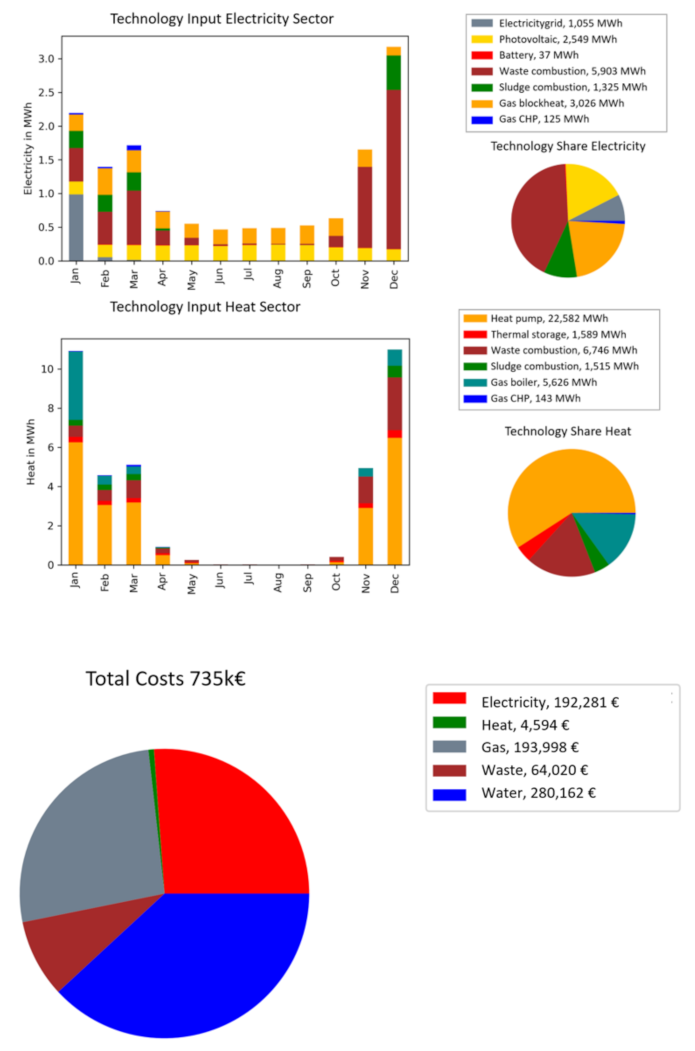

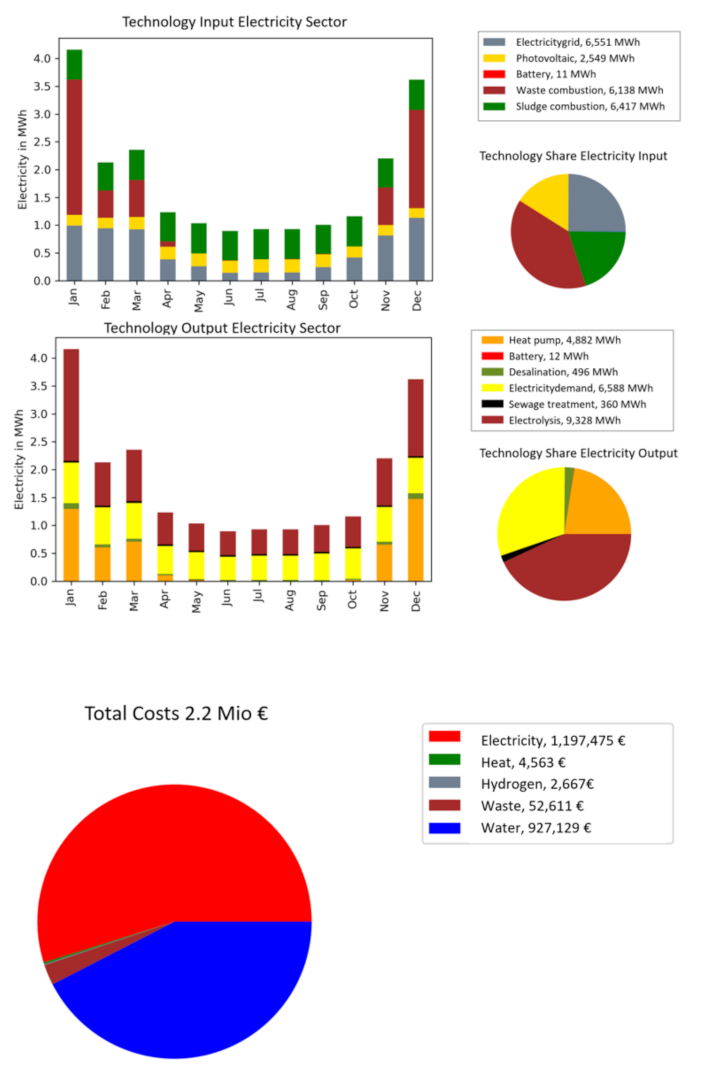


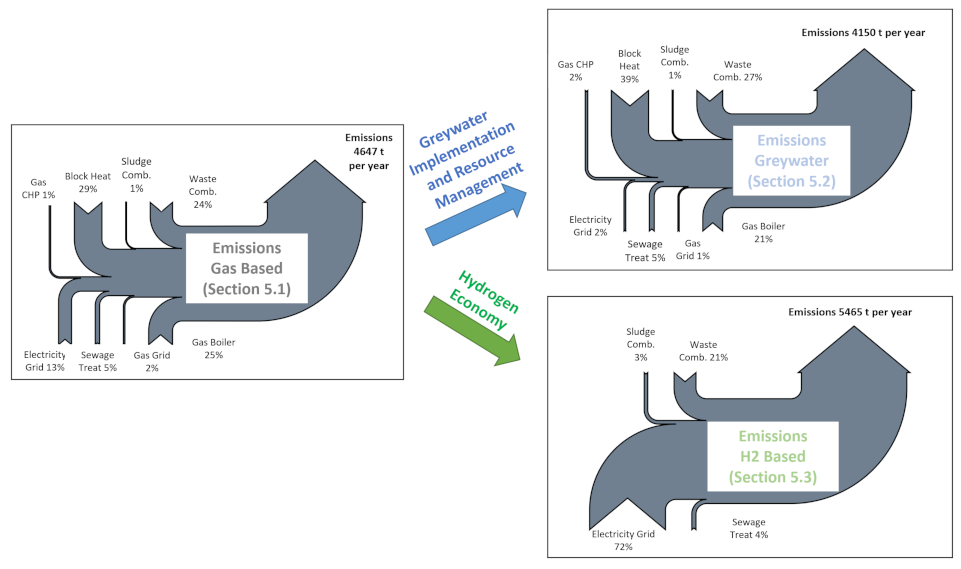
| Case | Greywater Share % | Electrolysis in MWh | Electrolysis Water in |
|---|---|---|---|
| No scarcity constraint | 0 | 9330 | 2640 |
| Limit () | 0.3 | 9330 | 2640 |
| Scarcity time-series | 17.9 | 9330 | 2640 |
| CO2 | El. Grid % | Gas-Grid % | Gas to El. % | Comb. to El. % | CO2 in t/year |
|---|---|---|---|---|---|
| 0 €/tCO2 | 7.5 | 20.6 | 22.5 | 51.6 | 4720 |
| 30 €/tCO2 | 7.5 | 20.9 | 22 | 52.1 | 4647 |
| 120 €/tCO2 | 7.5 | 21.6 | 21.6 | 52.6 | 4531 |
| 500 €/tCO2 | 7.5 | 21.1 | 22.9 | 51.1 | 4477 |
| 800 €/tCO2 | 7.3 | 23.4 | 19 | 55.8 | 4302 |
| Opt Grid | 0 | 48.3 | 18.6 | 62.9 | 3561 |
| Opt Local | 0 | 40.1 | 31.3 | 55.7 | 4002 |
Publisher’s Note: MDPI stays neutral with regard to jurisdictional claims in published maps and institutional affiliations. |
© 2022 by the authors. Licensee MDPI, Basel, Switzerland. This article is an open access article distributed under the terms and conditions of the Creative Commons Attribution (CC BY) license (https://creativecommons.org/licenses/by/4.0/).
Share and Cite
Maldet, M.; Schwabeneder, D.; Lettner, G.; Loschan, C.; Corinaldesi, C.; Auer, H. Beyond Traditional Energy Sector Coupling: Conserving and Efficient Use of Local Resources. Sustainability 2022, 14, 7445. https://doi.org/10.3390/su14127445
Maldet M, Schwabeneder D, Lettner G, Loschan C, Corinaldesi C, Auer H. Beyond Traditional Energy Sector Coupling: Conserving and Efficient Use of Local Resources. Sustainability. 2022; 14(12):7445. https://doi.org/10.3390/su14127445
Chicago/Turabian StyleMaldet, Matthias, Daniel Schwabeneder, Georg Lettner, Christoph Loschan, Carlo Corinaldesi, and Hans Auer. 2022. "Beyond Traditional Energy Sector Coupling: Conserving and Efficient Use of Local Resources" Sustainability 14, no. 12: 7445. https://doi.org/10.3390/su14127445








